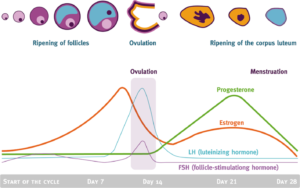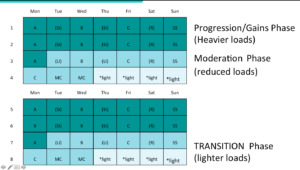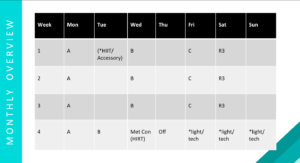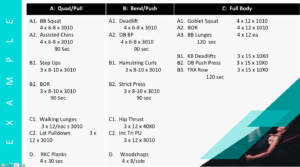How To Exercise Around Your Menstrual Cycle
(Note: This article originally appeared on the PTDC website )
The menstrual cycle lies at the core of a female’s health and well-being, and yet, it is rarely talked about in an in-depth manner within many personal trainer–client relationships. Whether her goal is to improve strength, gain muscle, or lose fat, you can educate her on how to use her menstrual cycle to her advantage, help accelerate her results, and keep her healthy.
By having a firm understanding of how the first phase of her cycle differs from her second phase (and all the subtle changes that occur within each phase of her cycle), you gain valuable insight into the length of her cycle, as well as the associated moods, energy fluctuations, cravings, body shape, and performance–all of which are influenced by her hormones. These then allow you to manipulate your training methods to get the best results for your female clients.
Before starting this conversation with your female client, please remember that every woman is unique. The success of ‘cycling your training,’ as we’ll call it, with her menstrual cycle lies in both of you having open and honest conversations about her body. You can add open-ended questions about her cycle into your screening process and explain the relevance of the information in a professional way. Mutual respect, trust, and professionalism are paramount.
Talking about the menstrual cycle should not be an awkward conversation. It only becomes awkward if you are uncomfortable, or you haven’t built enough rapport with the client.
Menstrual cycle 101
The menstrual cycle is the result of a complex series of hormonal changes involving the hypothalamus, pituitary glands, and ovaries (HPO axis). These important organs are instrumental to the development and regulation of body systems, like her reproductive and immune systems.
A normal menstrual cycle can be anywhere between 28 and 35 days. It can also differ in length of time, month to month. Encourage your female client to track her cycles so that you both gain an understanding of what her ‘normal’ cycle looks like. An app like Period Tracker is ideal for this.
As you read this, you will notice that this style of periodization differs considerably from the conventional style of periodization. Normally there aren’t so many changes within each mesocycle, but to recap simply remember:
- The first two weeks are focused on conventional strength or hypertrophy training parameters.
- The third week is focussed on metabolic conditioning.
- The last week is preparation for the menstrual cycle.
- Continue to repeat this cycling for 12-16 weeks before prescribing a new program.
Now let’s look at each physiological phase of the menstrual cycle from a prescription perspective:

Source: Precision Nutrition
The follicular phase is the best time for progression and gains.
The first phase of the cycle is the follicular phase. The follicular phase occurs between day one (first day of menses) and ovulation, during which an egg is released from the follicle. It is during this phase that the female hormone estrogen is at its highest.
Estrogen has a positive effect on mood, energy, and strength so your clients are more likely to feel good and experience improved physical strength. In other words, the follicular phase is the best time to be making big gains in her muscle mass and strength (by the way muscle and strength gains are CRUCIAL for all women over the age fo 40)
The focus for this phase should be on traditional strength and hypertrophy sessions, with some high-intensity intervals programmed in. Due to the increase in estrogen, her body will be able to cope and recover from a greater training volume than the luteal phase (which we will discuss next).
Toward the end of the follicular phase is ovulation. Ovulation is characterized by a sharp increase in all hormones, including a rise in testosterone. For some women, this is the best time to hit strength PRs.
The luteal phase is best for moderate conditioning exercises.
After the egg has been released during ovulation, it awaits to be fertilized. This is the luteal phase, or the time between ovulation and menstruation.
Initially, there is a dip in estrogen levels, but it rises again, along with the hormone progesterone. If a woman is in tune with her body, she may notice the subtle changes that occur during and after ovulation. There will be energy shifts, mood changes, and a compromised ability to recover from training. As she nears day one of her period, she may experience premenstrual symptoms (or PMS) and cravings.
As a side note, many women suffer from PMS, but just because it is common does not make it normal. “Normal” PMS symptoms include slight body discomfort and emotional changes, but it is not normal to experience crippling pain, severe breast tenderness, or symptoms that cause her to miss work. If you notice these in your client, or she shares with you that she is having changes in her cycle, please refer her to a qualified practitioner, such as a functional general practitioner, naturopath, or fertility expert, for further investigation.
During the luteal phase, it is important to alter the exercise prescription to match the energy and mood of the client. That means you should reduce overall load, use moderate weights, and shift towards mixed style training, like metabolic conditioning or circuit-style training (an example of this is my 5 x 5 Workout)
Of course, you can still continue to use conventional strength and hypertrophy prescriptions if they’re part of her goal. You need to ensure that the loads are reduced, or match her capability, however, especially as she nears the first day of bleeding. The reason is that if a woman suffers from bloating, cramping, and other premenstrual symptoms, her ability to activate her inner core unit will be impacted, leaving her vulnerable to injury if the weights are too heavy.
Focus on honoring her emotional and physical state during menstruation.
The transition phase is from the first day of bleeding (which is actually part of the follicular phase) until the end of menstruation.
Different women are affected differently by their period, so you should let your client determine what she is capable of doing at that moment in time. Some clients feel strong and are able to exercise at intensity or with heavy loads, whereas others do not feel good and would require a lighter session.
In other words, honor her emotional and physical state and prescribe exercises accordingly.
The focus here is on supporting the body. Ensure that overall load is reduced, especially if she suffers from stomach cramps and pain. Concentrate on skills and technique work, bodyweight exercises, or lighter loads. Give her permission to rest her body during these few days. A few days of relaxation or super light training will actually improve her overall training.
Once her menstrual cycle comes to an end, there will be a marked increase in energy and improved mood, so that cycle starts all over again.
By changing your training approach to match your female client’s natural hormonal changes, she is more likely to experience improved results. By working with her body and not against it, she will experience improved exercise consistency, increased body awareness and intuition, and a much deeper and trusting trainer-client relationship.
Training Plan Example:
As examples, I’ve provided two mesocycles of training. This type of exercise prescription would be for a woman who is wanting to get strong and decrease body fat. They assume she has exercise experience and is free of injuries. Please also note it is assumed that a thorough warm-up with client-specific activation exercises have been completed before working out.



This can be quite a confusing topic for Fitness Professionals (and clients) to understand yet it is CRUCIAL for the overall health and success of female clients. After years of making mistakes in my business I finally learnt how to pay specific attention to the female body, what signs to look out for and how to best manipulate my exercise prescription to suit her lifestyle. I wish I had known this stuff when I first started PT but now I am known as leading expert in teaching PT’s how to train women. For ages I have been asked to put together a course and I have finally bought it into fruition!
Comments +